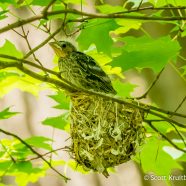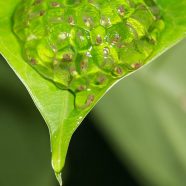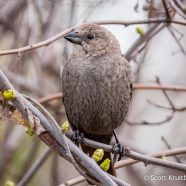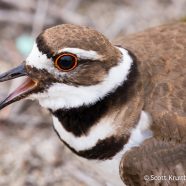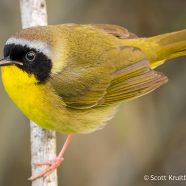Brown-headed Cowbird Nestling
This spring and summer seem to have been very successful for the Brown-headed Cowbird. I realize that this is largely anecdotal, but I have had and heard a lot of sightings and stories about various species discovered feeding a hatchling or fledgling Cowbird. From the American Redstart to the Chipping Sparrow, the Yellow-throated Vireo or the Yellow Warbler, an Orchard Oriole and a Common Yellowthroat, a Blue-winged Warbler or this nest that I found and photographed a couple of weeks ago, it has been Cowbirds here, there, and everywhere. What’s the common thread? All of these birds and...
Read MorePowdered Glass Frog (Teratohyla pulverata) Eggs
Bloop! Powdered Glass Frog (Teratohyla pulverata) eggs at the Cocobolo Nature Reserve in Panama as photographed by RTPI President Twan Leenders.
Read MoreBrown-headed Cowbirds
We seem to be at the peak season of reports of, “Why is this pretty bird feeding this huge baby bird that is twice its size?!” all thanks to the native Brown-headed Cowbird (Molothrus ater). Here we have a photo of a male followed by a female. The species is a brood parasite with the female laying eggs in nests of other birds to leave the burden of raising young to these unsuspecting parents by fooling them into thinking it is their own egg. It is also a rather clever way of not putting all of your eggs in one basket. These blackbirds are found in typical types of blackbird...
Read MoreKilldeer
I finally got around to editing these photos of a Killdeer (Charadrius vociferus) taken during the Noble Proctor BioBlitz Challenge last month. The bird appeared in the first photo like any other – no big deal. Oh no, this bird is “injured”! Not so much. This is a distraction display, feigning injury, in order to draw our group away from the area and protect a nest or young hatchlings. The bird makes it look like it has a broken wing and has lost the ability to fly, attempting to tempt mammals like us into running them down for a meal (before they fly away). If we did then...
Read MoreCommon Yellowthroat
This male Common Yellowthroat (Geothlypis trichas) and I are rather close…or at least we were for about 30 seconds on a recent May morning. This bird is a migrant, though you may end up with a resident in a yard near you. Their common name does betray their abundance, and gardens, marshes, fields, forests or anywhere they can skulk about in dense, low vegetation works for them. Being a habitat generalist has helped the species end up as one of our most common warblers. It also makes them a frequent target of Brown-headed Cowbirds and brood parasitism, like the abundant Yellow Warbler....
Read More



